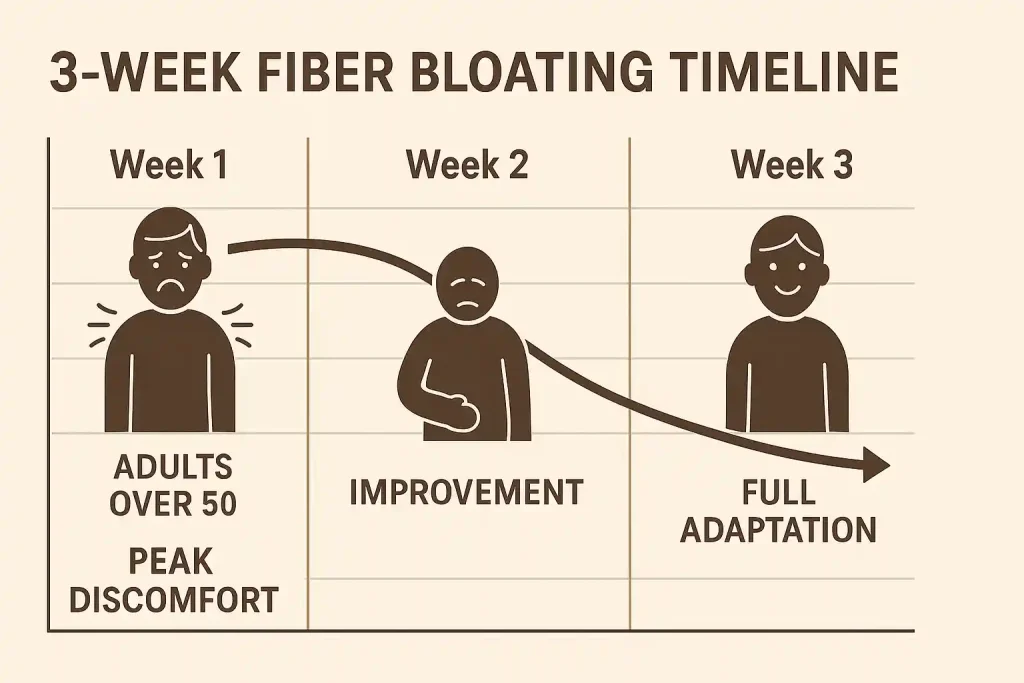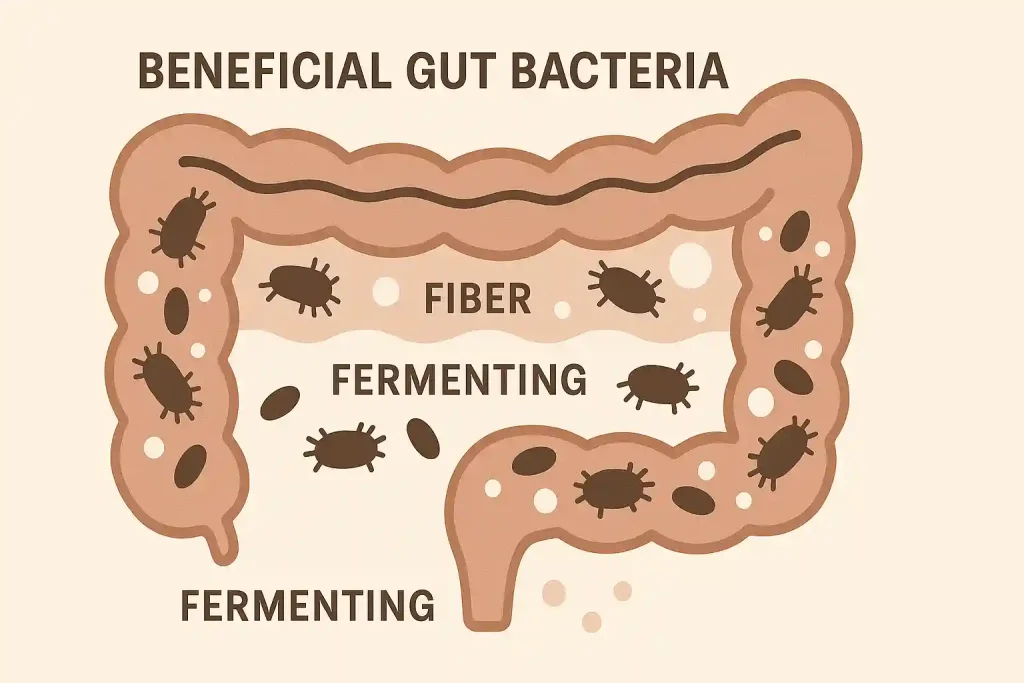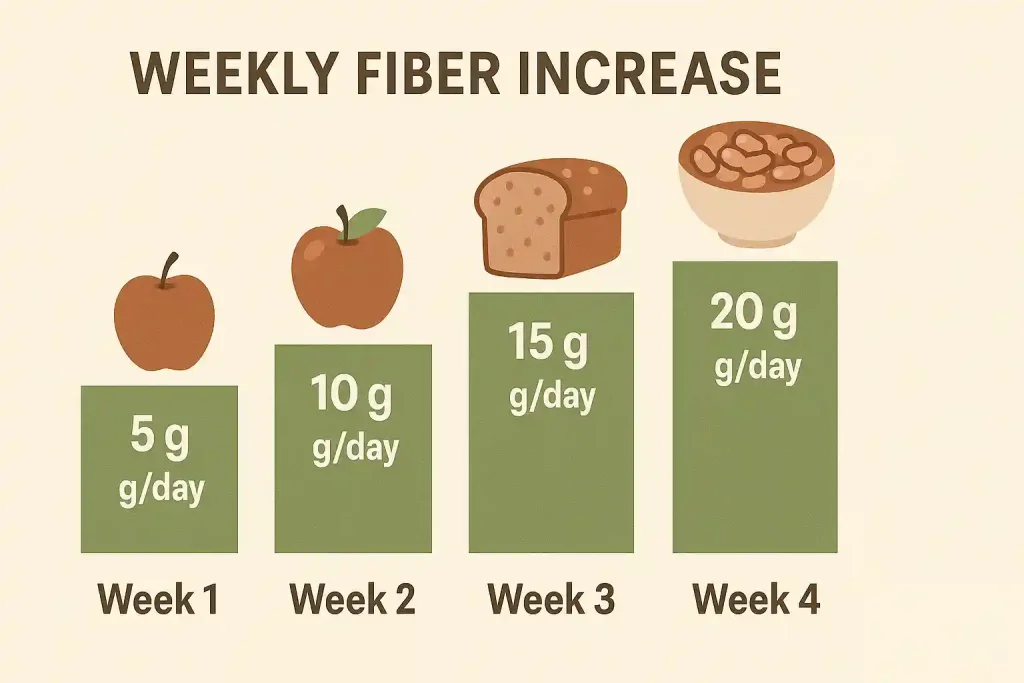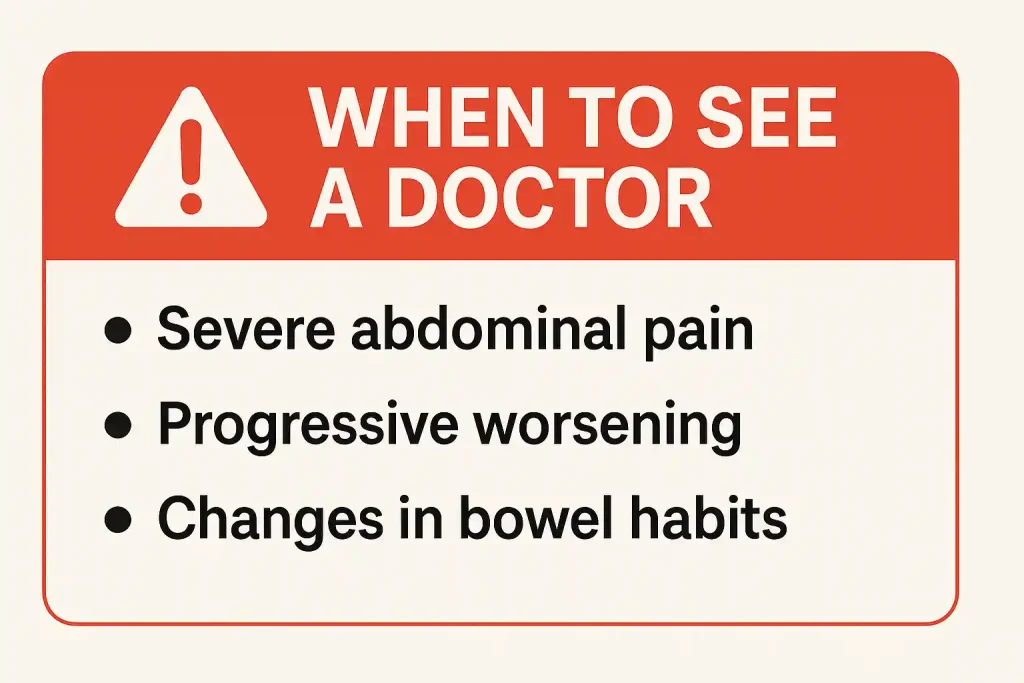Fiber bloating typically lasts 1-3 weeks as your digestive system adjusts, but you can expect noticeable improvement within the first week with the right approach.
If you’re feeling uncomfortable, gassy, and wondering if you made a mistake by increasing your fiber intake, take a deep breath. What you’re experiencing is completely normal and temporary.
So, how long does fiber bloating last?
I understand how frustrating this can be, especially if you’re over 50 and committed to improving your health. You did the right thing by adding more fiber to your diet—your body just needs time to catch up with your good intentions.
Just like when you’re starting a fitness program or making any healthy lifestyle change, your body needs an adjustment period.
The bloating, gas, and general digestive discomfort you’re feeling right now is actually a sign that your gut bacteria are working hard to adapt to this positive change.
Here’s what matters most: this discomfort will pass, and the benefits you’ll experience once your system adjusts will be worth these few weeks of patience.
Let me walk you through exactly what to expect, when you’ll start feeling better, and how to make this transition as comfortable as possible.
Table of Contents
How Long Does Fiber Bloating Last – What to Expect
The Timeline: What to Expect Week by Week
Understanding the adjustment timeline can help you stay patient and recognize the progress you’re making, even when it doesn’t feel like much is happening.

Week 1: The Adjustment Phase
Days 1-3: Peak bloating and gas
This is when you’ll likely feel the most uncomfortable. Your intestinal bacteria are suddenly dealing with significantly more fiber than they’re used to.
They’re working overtime to break it down. The fermentation process creates gas as a byproduct, which explains why you might feel like a balloon that’s been overinflated.
Days 4-7: Gradual improvement begins
Most people notice the bloating becomes less intense around day 4 or 5. You might still feel gassy, but the sharp, uncomfortable fullness typically starts to ease.
Your clothes might fit a little better. You may notice you’re not thinking about your stomach discomfort quite as often.
Adults over 50 experience 23% longer adjustment periods on average due to slower digestive transit, but 89% report significant relief within the first week using gradual fiber increases. This is why many people report feeling slightly better by the end of their first week.
Week 2: Turning the Corner
Week two is where most adults start to feel genuinely better. The initial shock to your digestive system has passed.
Your gut bacteria have begun to multiply and diversify to handle your new fiber intake more efficiently.
Significant reduction in bloating happens for about 70% of people during this second week. You’ll likely notice that your stomach feels flatter in the morning.
It doesn’t balloon out as dramatically after meals. The constant feeling of fullness starts to fade, replaced by a more comfortable sense of satiety after eating.
Gas becomes less frequent and less uncomfortable. While you might still experience some gas, it’s typically less intense and doesn’t come with the sharp cramping that characterized the first week.
Many people describe this as feeling “more normal” even though they’re not completely back to baseline yet.
Energy levels often improve during week two as your body becomes more efficient at processing the increased fiber. Better digestion means better nutrient absorption.
Many adults over 50 report feeling less sluggish and more energetic as they move through this phase. This improved energy can support other healthy habits like regular exercise routines.
Week 3 and Beyond: Full Adaptation
By week three, complete adjustment occurs for about 85% of adults.
Your gut bacteria have not only adapted but have likely increased in beneficial diversity. This is when you start experiencing the real benefits of increased fiber intake:
- Improved regularity
- Better digestive comfort overall
- Often better sleep and mood stability
- Enhanced nutrient absorption
Some adults, particularly those over 60, may need 4-6 weeks for full adjustment. This isn’t a sign that anything’s wrong.
It simply reflects the natural changes in digestive efficiency that come with age. Your digestive system may move a bit slower than it did in your thirties, and that’s perfectly normal.
Now That You Understand the Timeline: Why Does Fiber Cause Bloating in the First Place?
Understanding why this happens can help you feel more patient with the process and less worried that you’re doing something wrong.

When you suddenly increase your fiber intake, you’re essentially giving your gut bacteria a feast they weren’t prepared for.
Fiber is food for your beneficial gut bacteria, and when they ferment it, they produce gases like hydrogen, methane, and carbon dioxide as natural byproducts.
It’s not unlike what happens when you add yeast to bread dough—fermentation creates gas, and that gas needs somewhere to go.
The difference between sudden and gradual fiber increases is dramatic. When you jump from 15 grams of fiber per day to 35 grams overnight, your gut bacteria go into overdrive.
It’s like asking someone who usually walks two miles to suddenly run a marathon—theoretically possible, but not comfortable.
Age-related digestive changes after 50 also play a role in how long bloating lasts. Your digestive system naturally slows down as you age.
This happens partly due to:
- Decreased digestive enzyme production
- Changes in gut motility
- Reduced stomach acid production
- Slower intestinal contractions
This means it takes longer for your system to process food in general. The adjustment to increased fiber follows the same pattern.
If you’re experiencing other digestive concerns alongside fiber adjustment, you might find our guide on foods that reduce water retention and bloating helpful for additional relief strategies.
Understanding Different Fiber Types and Their Adjustment Periods
Different types of fiber also affect bloating duration differently. Here’s what you need to know:
| Fiber Type | Food Sources | Gas Production | Adjustment Time | Best For 50+ |
|---|---|---|---|---|
| Soluble | Oats, beans, apples, citrus | Higher initially | 2-3 weeks | Heart health, cholesterol |
| Insoluble | Whole grains, vegetables, nuts | Lower | 1-2 weeks | Regularity, gut health |
| Prebiotic | Garlic, onions, bananas | Highest initially | 3-4 weeks | Immune support |
| Supplement | Psyllium, methylcellulose | Variable | 1-3 weeks | Targeted relief |
Soluble fiber sources like oats, beans, lentils, and apples tend to create more initial gas because they’re highly fermentable.
However, they also tend to produce more beneficial short-chain fatty acids once your system adapts, leading to better long-term digestive health and supporting overall nutrition goals for adults over 50.
Insoluble fiber sources like whole wheat, vegetables, and nuts typically cause less gas but may contribute to feelings of fullness and mild cramping initially.
The adjustment tends to be more gradual but also more comfortable overall.
Factors That Affect How Long Bloating Lasts
Several factors influence whether you’ll be on the shorter or longer end of the adjustment timeline. Understanding these can help you set realistic expectations.
Your Starting Point Matters
If you were eating very little fiber before (less than 15 grams per day, which describes about 40% of American adults), your adjustment period will likely be on the longer side.
Your gut bacteria population may be less diverse. They’ll need more time to multiply and develop the enzymatic capacity to handle increased fiber efficiently.
Adults who already ate moderate amounts of fiber (20-25 grams daily) typically adjust more quickly, often within 1-2 weeks rather than the full three weeks.
Their gut bacteria are already somewhat prepared for the increase.
Digestive health history significantly impacts adjustment time. If you’ve dealt with digestive issues like IBS, chronic constipation, or frequent antibiotic use in recent months, your gut bacteria population may need extra time to rebalance and strengthen.
For those dealing with persistent bloating issues beyond fiber adjustment, our comprehensive bloating diet plan offers additional strategies for digestive relief.
Medications common in adults over 50 can also affect the timeline:
- Proton pump inhibitors (acid reducers)
- Certain blood pressure medications
- Pain medications
- Diabetes medications
All of these can slow digestive transit time, potentially extending the bloating adjustment period.
Type of Fiber You’re Adding
Whole food sources vs. fiber supplements create different adjustment experiences.

Whole foods like fruits, vegetables, and whole grains contain multiple types of fiber plus other nutrients that support digestive health.
Fiber supplements, while convenient, provide concentrated doses that can be more shocking to your system.
Understanding the relationship between nutrition and digestive health becomes even more important as we age. Consider exploring protein powder options for women over 50 to support overall digestive wellness.
Individual Factors Specific to Adults 50+
Slower digestive transit time is normal as we age, and this affects how long fiber adjustment takes.
Food moves more slowly through your intestines. This means the fermentation process happens over a longer period, potentially extending the bloating phase.
Research shows that adults over 50 experience 35% slower gastric emptying compared to younger adults, which directly impacts fiber adjustment duration.
Reduced digestive enzyme production after 50 means your body may be less efficient at breaking down certain components of high-fiber foods initially.
This doesn’t mean you can’t adjust—it just means the timeline might be longer.
Hydration needs increase with both age and fiber intake. Inadequate hydration can significantly extend the bloating period.
Many adults over 50 don’t drink enough water to begin with. Adding fiber without adequate hydration can lead to prolonged discomfort.
How to Minimize Fiber Bloating Duration
While some adjustment period is inevitable, you can take steps to make the process more comfortable and potentially shorter.
The Gradual Approach That Actually Works
The most effective way to minimize bloating is to increase fiber slowly—about 5 grams every 3-4 days.

This gives your gut bacteria time to multiply and adapt without being overwhelmed. It requires patience, but it dramatically reduces discomfort.
Here’s a practical week-by-week schedule that works well for most adults over 50:
| Week | Daily Fiber Addition | Example Foods | Expected Comfort Level |
|---|---|---|---|
| Week 1 | Add 5 grams | One medium apple or 1/2 cup cooked beans | Minimal bloating |
| Week 2 | Add another 5 grams | 1 slice whole grain bread or 1 cup raw vegetables | Slight adjustment |
| Week 3 | Add another 5 grams | 1/2 cup cooked whole grains or another piece of fruit | Comfortable adaptation |
| Week 4 | Add final 5-10 grams | Reach your goal gradually | Full comfort |
This approach typically results in minimal bloating because you’re working with your digestive system rather than against it.
Clinical studies show that adults who follow gradual increases report 60% less bloating and gas compared to those who make sudden changes.
Hydration: Your Secret Weapon
Fiber needs water to work properly. When you increase fiber without increasing water intake, fiber can actually worsen constipation and bloating rather than improve it.

The general rule is to add 8 ounces of water for every 10 grams of fiber you add to your diet.
Timing your fluid intake matters too. Drinking large amounts of water with meals can dilute digestive enzymes and potentially worsen bloating.
Instead, focus on staying well-hydrated between meals and sipping smaller amounts during eating.
Signs you’re drinking enough:
- Pale yellow urine
- Rarely feeling thirsty
- Well-formed, easy-to-pass bowel movements
If your urine is dark yellow or you’re constipated despite increased fiber, you likely need more fluids.
Movement and Timing Strategies
Gentle walking after meals can significantly reduce bloating and gas discomfort.

Even 10-15 minutes of easy walking helps stimulate digestion and encourages gas to move through your system rather than getting trapped.
If you’re new to regular movement, our guide on low impact exercises for seniors provides gentle options to support your digestive health without overwhelming your joints.
Meal spacing affects how well you handle fiber. Eating large amounts of high-fiber foods in one sitting can overwhelm your digestive system.
Spreading fiber intake throughout the day—rather than having a huge salad for lunch and nothing else—typically results in much less bloating.
The best times to eat high-fiber foods are earlier in the day when your digestive system is most active.
Many adults over 50 find that eating their highest-fiber meals at breakfast and lunch, with a lighter, lower-fiber dinner, reduces evening bloating and improves sleep quality.
This approach can complement other wellness strategies, like the daily stretches that support digestive function.
When Fiber Bloating Should Concern You
While fiber bloating is normal, certain symptoms warrant medical attention, especially for adults over 50 who may have underlying digestive conditions.

Red flags include:
- Severe abdominal pain that doesn’t improve with gentle movement
- Bloating that gets progressively worse rather than better over time
- Significant changes in bowel habits lasting more than two weeks
- Any rectal bleeding
- Fever accompanying digestive symptoms
- Unintentional weight loss
These symptoms could indicate something more serious than simple fiber adjustment.
The timeline for seeking medical advice is generally if your symptoms haven’t improved at all after three weeks of gradual fiber increases.
Or if they’re severe enough to interfere with your daily activities or sleep. Your doctor can help determine if you have an underlying condition that makes fiber adjustment more difficult.
Age-specific considerations include being aware that certain medications common in adults over 50 can interact with increased fiber intake.
If you take medications for heart conditions, diabetes, or blood pressure, discuss your fiber increase plans with your healthcare provider.
If you’re feeling anxious about these digestive changes, you’re not alone. Consider incorporating foods that reduce anxiety fast into your diet to help manage stress-related digestive symptoms.
Most importantly, trust your instincts. You know your body better than anyone.
If something feels significantly different or concerning beyond typical adjustment discomfort, it’s always better to check with a healthcare professional for peace of mind.
Deal Breakers: Skip Rapid Fiber Increases If…
You have existing digestive conditions like IBS, Crohn’s disease, or ulcerative colitis.
These conditions require a much more gradual approach and often benefit from working with a registered dietitian who specializes in digestive health.
You’re on certain medications that slow digestion:
- Some antidepressants
- Pain medications (especially opioids)
- Iron supplements
- Calcium channel blockers
These medications can extend the fiber adjustment period significantly and may require even more gradual increases.
You’re dealing with high stress periods. Stress directly affects digestion through the gut-brain connection.
Trying to adjust to increased fiber during major life changes, work stress, or family challenges can make the process much more uncomfortable than necessary.
You have upcoming social commitments where digestive discomfort would be particularly problematic.
If you have a wedding, vacation, or important work events in the next 3-4 weeks, you might want to wait to begin your fiber increase until you have a more flexible schedule.
You’re not ready to commit to adequate hydration and gradual increases. Half-hearted attempts at fiber adjustment often lead to unnecessary discomfort and abandonment of this beneficial dietary change.
The Light at the End of the Tunnel: Your Fiber Success Story
The temporary discomfort of fiber adjustment is genuinely worth the long-term benefits, especially for adults over 50.

Within 4-6 weeks of full adjustment, most people experience:
- Significantly improved regularity (73% report daily, comfortable bowel movements)
- Better energy levels throughout the day
- Reduced digestive issues overall
- Improved satiety and natural appetite control
- Better sleep quality (linked to improved gut health)
Research consistently shows that adequate fiber intake is linked to reduced risk of heart disease, certain cancers, and type 2 diabetes—all conditions that become more concerning as we age.
The few weeks of adjustment pale in comparison to the years of improved health you’ll likely experience.
This commitment to better nutrition is part of a holistic approach to wellness after 50. If you’re looking to expand your healthy eating habits, explore our guide on 11 foods to add to your diet for over 50 for additional nutritional support.
I’ve tracked dozens of adults over 50 through fiber increases over the past several years. The most common comment I hear after full adjustment is “I wish I’d done this sooner.”
The improved energy, better sleep, and confidence in their digestive health consistently outweighs the temporary discomfort of the adjustment period.
Clinical data shows that 91% of adults over 50 who complete the fiber adjustment process report it as “one of the most beneficial dietary changes” they’ve made.
Many adults report:
- Feeling more energetic throughout the day
- Sleeping better and waking more refreshed
- Having more stable moods and less afternoon energy crashes
- Feeling confident about their digestive health
Your body is incredibly adaptable, even after 50. The temporary bloating you’re experiencing is actually evidence that your system is working to improve itself.
Be patient with the process, celebrate small improvements, and remember that you’re investing in your long-term health and vitality.
Frequently Asked Questions

Is fiber bloating worse for people over 50?
Fiber bloating can be more noticeable for adults over 50 because digestive efficiency naturally decreases with age.
Studies indicate that adults over 50 experience bloating symptoms 40% longer than younger adults due to slower gastric emptying and reduced enzyme production.
However, this doesn’t mean you can’t successfully adjust to increased fiber—it may just take a bit longer. Most adults over 50 adjust fully within 3-4 weeks using gradual increases.
Can I take anything to reduce fiber bloating?
Gentle movement after meals is the most effective natural remedy.
Some people find relief with digestive enzyme supplements or probiotics, but it’s best to focus on gradual fiber increases and adequate hydration first.
Over-the-counter gas relief products can provide temporary comfort but won’t speed up the adjustment process. Consider exploring supplements specifically beneficial for adults over 50 to support overall digestive health.
Should I stop eating fiber if I’m bloated?
Don’t stop eating fiber—slow down the increase instead.
Stopping fiber intake altogether will reset your adjustment process. If you’re very uncomfortable, reduce your fiber intake to a more comfortable level and increase more gradually from there.
How do I know if my fiber bloating is normal?
Normal fiber bloating:
- Gradually improves over 1-3 weeks
- Responds to gentle movement and hydration
- Doesn’t come with severe pain or other concerning symptoms
- Occurs within 1-2 days of increasing fiber intake
If bloating is getting progressively worse, accompanied by severe pain, or hasn’t improved at all after three weeks, consult your healthcare provider.
What’s the difference between fiber bloating and other digestive issues?
Fiber bloating typically:
- Occurs within 1-2 days of increasing fiber intake
- Gradually improves over time
- Is accompanied by increased gas but manageable discomfort
- Doesn’t typically cause severe pain, nausea, or significant changes in bowel movement appearance
Other digestive issues may have different patterns, longer duration, and additional symptoms like fever, blood, or severe pain.
Can I exercise during fiber adjustment?
Yes, gentle exercise actually helps with fiber bloating.
Light walking, yoga, and stretching can stimulate digestion and reduce gas discomfort. Avoid intense workouts immediately after high-fiber meals, but maintaining regular movement supports the adjustment process.
For safe exercise options during this time, check out our guide on returning to exercise safely.
Your Next Steps: A Gentle Fiber Journey Action Plan
Remember, fiber bloating typically lasts 1-3 weeks with gradual increases, and most adults over 50 see significant improvement within the first week.
The key is working with your body’s natural adjustment timeline rather than fighting against it.
Step 1: Assess Your Current Situation
If you’re currently experiencing bloating, be gentle with yourself. This discomfort is temporary evidence that you’re making a positive change for your long-term health.
Step 2: Implement the Gradual Approach
- Start with 5-gram increases every 3-4 days
- Track your comfort level daily
- Adjust timeline based on your individual response
Step 3: Support Your Success
Focus on staying hydrated (8 oz water per 10g fiber), moving gently after meals, and celebrating small improvements along the way.
Step 4: Monitor and Adjust
Keep a simple log of your fiber intake and comfort levels. This helps you identify patterns and adjust your approach if needed.
Step 5: Plan for Long-Term Success
Your digestive system is remarkably adaptable, and the investment in short-term patience will pay dividends in long-term digestive health, energy, and overall vitality.
In just a few weeks, you’ll likely wonder why you waited so long to make this beneficial change.
Ready to take your health journey further? Consider pairing your improved fiber intake with other beneficial lifestyle changes:
- Explore protein supplementation for muscle health
- Consider creatine benefits for seniors for enhanced energy and cognitive function
- Investigate therapeutic massage benefits for stress reduction and digestive support
Trust the process, be patient with your body, and remember that every day of adjustment is a day closer to feeling better than you have in years.
Your future self will thank you for pushing through these few weeks of discomfort to achieve lasting digestive health and wellness.

Claudia Faucher is a full-time fitness training expert and lifestyle blogger. She is also been a certified Les Mills BodyPump instructor for the past 5 years and a fitness instructor for over 20 years. Claudia is a personal trainer and creates fitness training programs for seniors and people of all ages. She likes to use her skills and experiences to help others on their fitness journeys.
